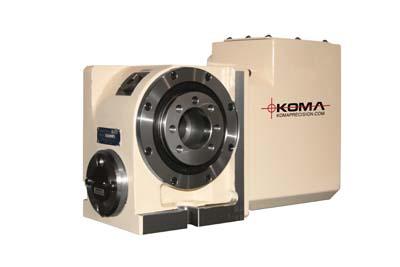
KOMA Precision Inc. has introduced a new line of high performance, attractively priced 4th axis rotary tables from Tsudakoma. The RNE Series 4th axis rotary tables are compact, high-performance tables offered at economy line pricing.
Four new models are available, ranging from the RNE-160 with 6.3" (160mm) face-plate capacity to the RNE-320 with 12.6" (320mm) face-plate capacity. The RNE Series tables feature speeds ranging from 25 to 44.4 RPM and indexing accuracies ranging from 10 to 12.5 arc seconds. Various options such as chucks, tailstocks, support spindles and faceplates are available. Pneumatic and hydraulic rotary joints for automatic load and unload of the work piece are also available.
Like all Tsudakoma rotary tables, the RNE Series feature heavy-duty construction, combining Tsudakoma casting material with Tsudakoma's dual lead worm gearing system featuring the largest tooth engagement of any rotary table manufacturer. This proprietary gearing system generates up to 85 percent torque transfer efficiency. These tables also feature Tsudakoma's ultraprecision cross roller bearings that support radial, axial and movement loads four times the level of stiffness as angular contact bearings.
"Koma Precision Inc. and Tsudakoma share a commitment to providing quality products that maximize the performance of machine centers," states Hiro Ichikawa, OEM Sales Manager for KOMA Precision. "The features offered on the RNE Seriesare ideal for those looking for economical ways to improve the flexibility and productivity of their operation without compromising rigidity and accuracy."
Contact Details
Related Glossary Terms
- centers
centers
Cone-shaped pins that support a workpiece by one or two ends during machining. The centers fit into holes drilled in the workpiece ends. Centers that turn with the workpiece are called “live” centers; those that do not are called “dead” centers.
- stiffness
stiffness
1. Ability of a material or part to resist elastic deflection. 2. The rate of stress with respect to strain; the greater the stress required to produce a given strain, the stiffer the material is said to be. See dynamic stiffness; static stiffness.

